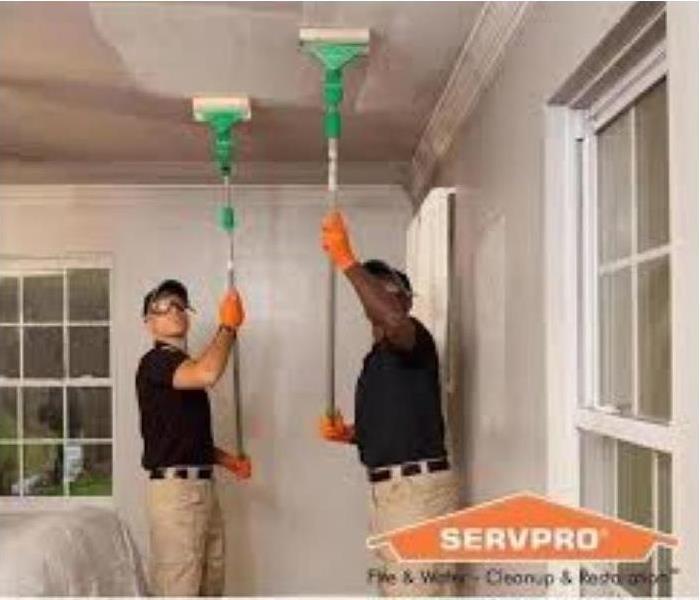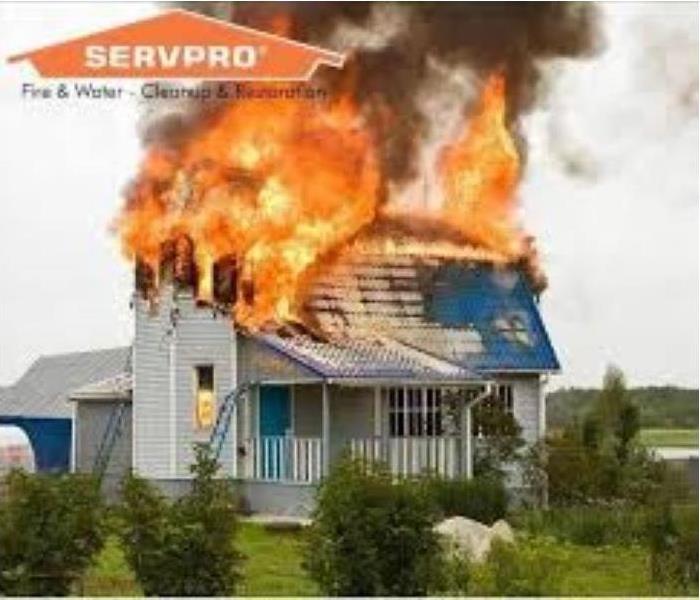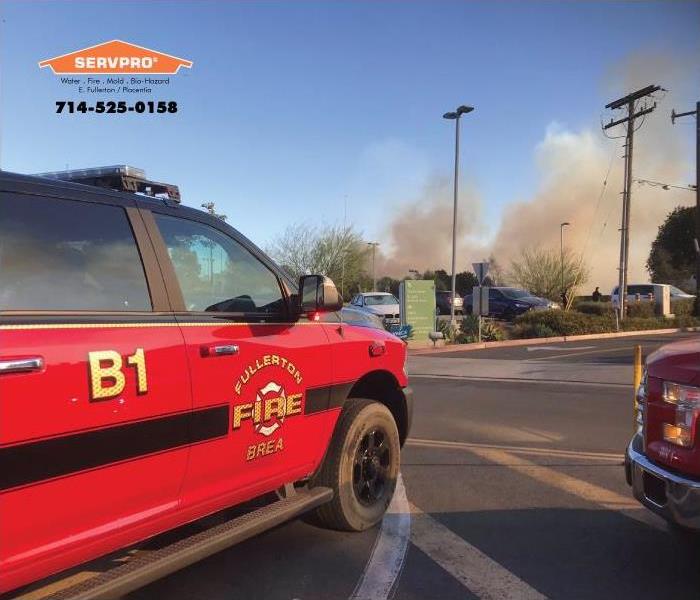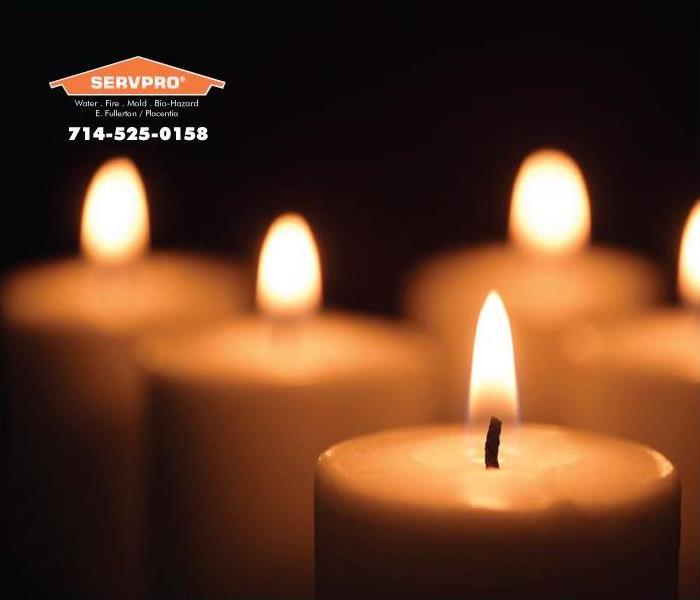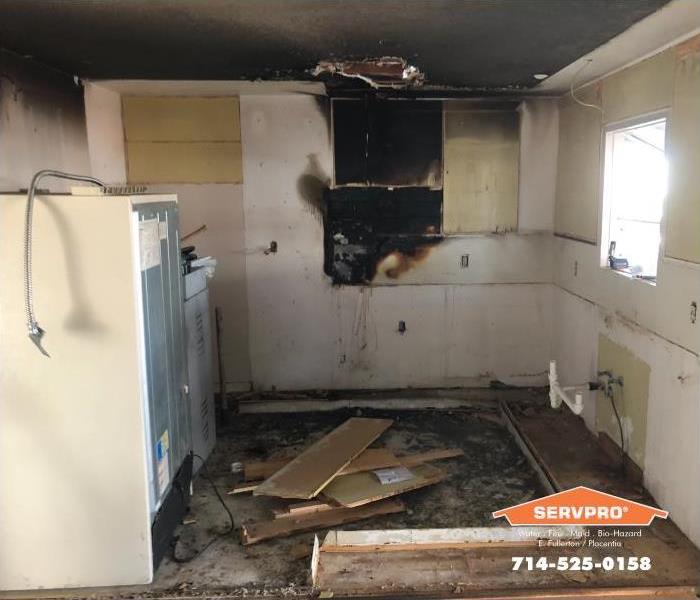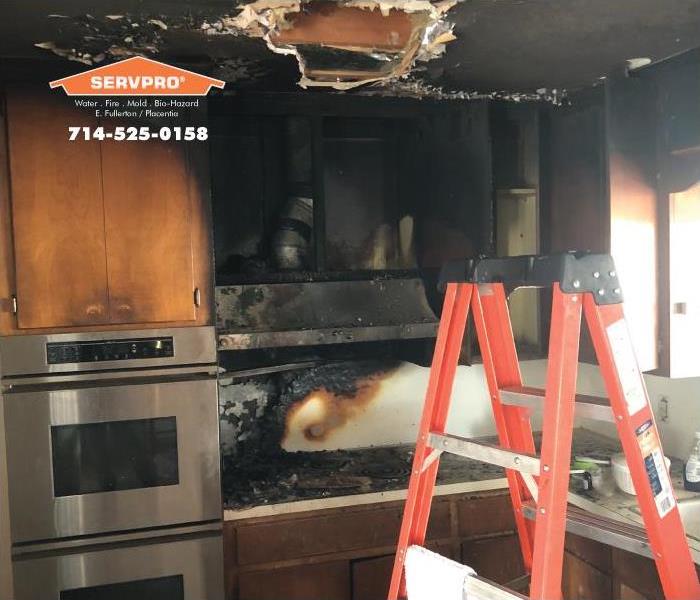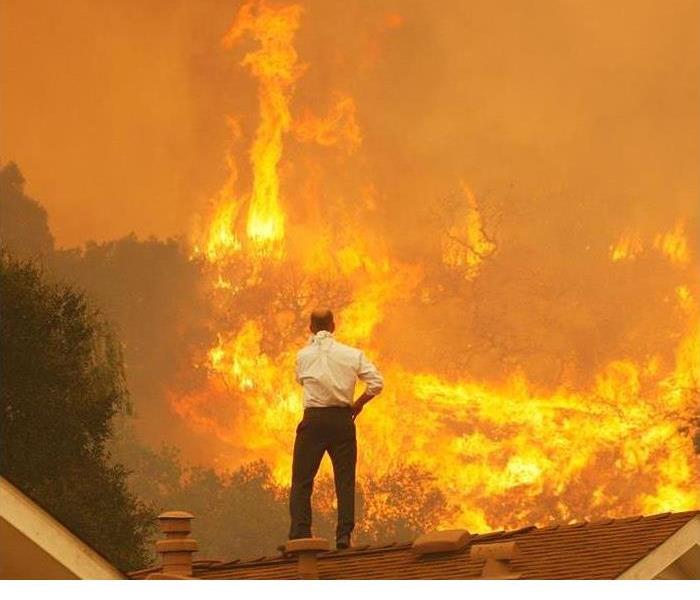Recent Fire Damage Posts
Teaching Kids Fire Safety | SERVPRO of East Fullerton/Placentia
2/7/2024 (Permalink)
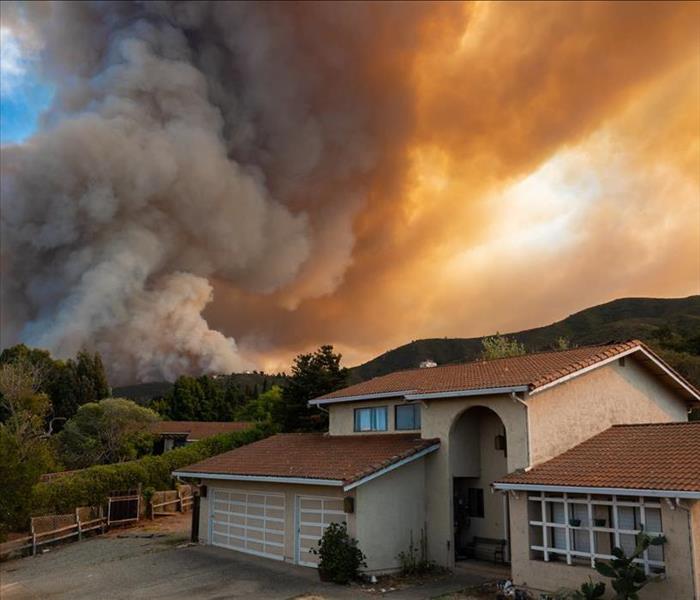 Unexpected fires can be devastating to your home. That's why SERVPRO of East Fullerton/Placentia can restore your home with a quick response. Call us!
Unexpected fires can be devastating to your home. That's why SERVPRO of East Fullerton/Placentia can restore your home with a quick response. Call us!
There is so much we do every day to protect our children and keep our homes safe. Both of these responsibilities can be almost daily tasks—there are so many risks and hazards we have to be prepared for!
Along with ensuring our homes are ready to handle each season and our children are ready to handle schools and growth milestones, we need to also make sure both are ready for potential fires.
Teaching your kids fire safety is crucial to ensure you can all get out in the event of a disaster. There are ways you can prepare your home and your family without creating a lot of fear. Spend some time talking about fire safety with your family to keep everyone safe.
Start With Prevention
In order to prevent creating fear as you prepare your kids for a fire, start by sharing with them the fire prevention tools you have in place at home. Walk them through the house and show them where your smoke detectors are.
These should be placed outside of every sleeping area and on every floor of your home. Turn them on while your kids listen so that they know what they sound like and you know their batteries are good.
Talk with your kids about the power of fire, and teach them to never play with matches or lighter. Children are naturally curious about how things work, so further protect them by keeping matches and lighters out of their reach.
Remove candles from your home as well. Flameless candles are a great alternative and can still offer the ambiance and even the smell of a regular candle without the risk.
If your kids are older and utilize appliances in the kitchen, make sure they know how to properly respond if something sparks. There should always be a pot lid close by to smother flames, but also keep a fire extinguisher in the kitchen. Teach older children how to use them. Remind them to always turn heat sources off and to unplug appliances when they are not in use.
Make a Plan
Disasters can still strike in even the most prepared home. While ensuring you have plenty of prevention in place is crucial for protecting your loved ones, you also need to make a plan so they know how to respond if things get out of control. Fires can spread rapidly, leaving you less than two minutes to safely get out.
Draw a basic map of your home with your children. Make a game out of deciding what the fastest route out of each room is. Set a timer and have them race to see who can get out of a space and to a safe meeting spot outside of the home the fastest. Do a belly crawl race as well so that your children can learn how to stay low and avoid smoke in a fun way.
Talk to your children about safely navigating stairs in their exit route and how you will handle exiting out a window when it is the only option. Practice your plan regularly, and play your escape games. The more you can make your family comfortable, the better a potential disaster scenario will go.
Do you have damage from a fire in your home? Contact our SERVPRO® team, and we will get things back to normal fast!
Facts About Garages and Car Fires
10/31/2023 (Permalink)
All too often today, we hear sensational stories about Electric Vehicles (EVs) bursting into flames in home garages. When they do occur, these fires will burn at intensely high temperatures and fire departments find them far more difficult to extinguish than fires involving gas or diesel powered vehicles. Extinguishing an EV fire requires copious amounts of water that can become contaminated with lithium and other chemicals and firefighters and others can be exposed to electrocution risks. But, EV and hybrid vehicle fires don’t occur all that often and the concerns of homeowners or property managers of public parking facilities can be diminished when the facts are more closely examined.
Firefighting tactics don’t work the same on electric vehicles as on gas powered vehicles. Lithium ion battery fires are more tricky to put out, sometimes they can reignite hours, days or even a week later. Since California has the highest number of EVs and hybrid (gas and electric) vehicles among the 2.5 plus million such vehicles in the U.S., we have significant risk exposure. Studies have shown that fire occurrences among gas, hybrid and electric powered vehicles differ significantly. Hybrid-powered cars are the most prone to experiencing fire and have been involved in about 3.5% of vehicles sold (3,475 fires per every 100,000). Gasoline-powered cars experience 1.5%, (about 1,530 fires per every 100,000) vehicles. And in spite of the sensational headlines, electric vehicles (EVs) saw just 25 fires per 100,000 (.00025%) of vehicles sold.
So Do You Need To Protect Your Garage from a Fire?
The answer is yes – no matter what vehicle type you park there. A majority of garages contain flammable substances and electrical situations that are easy to ignite. You can vastly decrease the odds of a garage fire by following these simple garage-keeping safety steps:
- For gas or hybrid car owners, inspect regularly for gas and oil leaks. Clean them up and get repairs started immediately.
- For EV owners, avoid over-charging EVs. The U.S. Fire Administration recommends owners avoid charging their EVs overnight and park EVs that need repair outside. Not charging to 100% every time will also help prevent overheating.
- Have an electrician inspect your wiring before installing EV chargers to ensure they will handle the high voltages necessary to charge the vehicle. Older homes and damaged systems may be unable to charge EVs safely.
- Store any oil, gasoline, propane, paint and varnishes in a structure like a shed that isn’t connected to the rest of the house – these are highly flammable and shouldn’t be stored in your garage.
- If you have washers, dryers, refrigerators, shop vacs and other appliances in your garage don’t store any items on top of the machinery as it can lead to a fire.
- Always avoid overloading electrical outlets with multiple plugins. Overloaded outlets are a leading cause of garage (and home) fires.
- Avoid using extension cords in garages, especially when powering or charging appliances. It just adds another danger that wires could short and spark a fire.
- Sweep your garage frequently and throw out unneeded stuff. The more clutter, the more fire hazards.
- Never install a solid-fuel burning device in a garage. It’s against building codes and a serious fire hazard.
- Install a heat alarm instead of a smoke alarm in your garage. A heat alarm is more consistent and reliable. Smoke alarms are prone to sound off when the temperature gets too hot, or dust and fumes interfere with its reading. False smoke alarms will bug you so you’ll soon detach the monitor anyway.
October is National Fire Protection Month; a good time to inspect and apply some common sense so that home garages, basements and attics aren’t neglected year-round.
Fire Damage to Your Fullerton Business Needs Our Professional Remediation
12/2/2021 (Permalink)
The possibility of a fire in your Fort Worth restaurant kitchen cannot help but be always in the back of your mind as an owner. Although the devastation a fire can cause might seem impossible to overcome in the immediate aftermath, our highly-qualified technicians have great success using our inventory of state-of-the-art equipment and restoration best practices mastered in Institute of Inspection, Cleaning and Restoration Certification (IICRC) courses.
The safety of both diners and employees is your priority if a fire damages your Fort Worth restaurant. Ensuring that your business recovers from the disaster fulfills our mission to provide industry-leading remediation services to the businesses in our community. Our crews mobilize fast, traveling to your site as soon as possible after your call.
Speed is crucial when mitigating the effects of fire damage. Within the first minutes and hours after the flames extinguish, fire residues pose the risk of progressive and permanent harm to structural components and the contents of your restaurant. SERVPRO crew members evaluate the types of residues found throughout your kitchen, dining rooms, storage areas, and other spaces.
We match appropriate products and methods to the different characteristics of soot coating surfaces. Protein-based soot is common in kitchen fires, depositing a thin and highly malodorous film that is hard to remove without solvents and abrasive tools. SERVPRO technicians can use barriers and air scrubbers to contain the cooking area, preventing the spread of debris to other spaces.
Even if your quick-thinking staff knocked down the flames with chemical extinguishers, secondary effects of the fire could linger. Persistent odors are particularly troublesome in an eating establishment as they interfere with the enjoyment of diners as they order and eat from your tempting menu. SERVPRO employees who complete the IICRC Odor Control Technician (OCT) course follow a research-based protocol to eliminate the stench in your establishment.
If clearing away charred items and thorough cleaning does not do the trick, SERVPRO turns to innovative techniques like thermal fogging or hydroxyl generators to eradicate the noxious smell. Thermal fogging recreates the fire environment, combusting deodorizers at high temperatures, so they attach to odoriferous particles and neutralize them. Hydroxyl radicals produced when ultraviolet rays react with water vapor (H2O) and oxygen (O2) dismantle the odor-bearing molecules. We this cutting-edge technology as a more successful and sustainable alternative to masking agents.
Contact SERVPRO of E. Fullerton Placentia as soon as firefighters release your commercial property for abatement assessment. Call (714) 525-0158 day or night to schedule an inspection and develop a remediation and deodorization plan.
What are the common causes of home fires in winters?
12/2/2021 (Permalink)
As the winters and the holiday season arrives, fire safety becomes an important issue. During this time, there is an increased risk of fires and other hazards, including carbon monoxide and electrical fires. SERVPRO, a fire damage restoration company, discusses the various causes of winter fires that homeowners must watch out for.
Heating is the second leading cause of US home fires and home fire injuries and the third leading cause of home fire deaths. The winter months of December, January, and February are when fires peak in the country. These fires can spark when a heater is too close to combustible materials or when the device malfunctions mechanically or electrically. Space heaters account for more than two of every five fires (44%), as well as the vast majority of deaths and injuries in home fires caused by heating equipment.
Turn off space heaters before leaving a room and make sure space heaters have at least three feet of clearance from everything in the house.
Furnaces need a special mention here. To avoid chimney fires, a qualified professional should inspect the chimney and vents every year. The cooled ashes from the fireplace must be stored tightly covered in a metal container and the container should be placed outside, at least 10 feet away from the house and any other buildings. The fireplace must be cleared of anything that might catch flame, and should never be left with fire, unattended.
Carbon monoxide is an odorless, colorless gas created that builds up in enclosed or partially closed spaces by burning fuel such as gas, wood, and propane in various appliances and machines. These appliances include stoves, fireplaces, gas ranges, lawnmowers, electric generators, cars, and more. Installing a CO detector and regular inspection of all heating appliances is recommended to protect from carbon monoxide poisoning.
Portable generators are indispensable when power outages occur during winter storms. However, the improper use of portable generators can lead to dangers such as carbon monoxide (CO) poisoning, electrical shock or electrocution, and fire hazards. Statistics show that half of the generator-related deaths happened in the four coldest months of the year, November through February.
The holiday season brings in a lot of candle burning with December being the peak time. Each year between 2013-2017, an average of 7,900 home candle fires were reported each year. Homeowners must never leave candles unattended, and make sure they’re in a safe place where they can’t be tipped over. Candles must be extinguished before going to bed.
Electrical home fires are the leading cause of home fires in the U.S. Almost half of all home electrical fires were caused by electrical distribution or lighting equipment, while the other half involved other known types of equipment like washer or dryer fans and portable or stationary space heaters. Don’t overload electrical outlets or run extension cords under carpets, across doorways, or near heaters.
The 7-step Fire Restoration Process for Commercial Buildings
12/2/2021 (Permalink)
Fire damage restoration for commercial buildings
Immediate action after a commercial fire is important to prevent further damage and foster swift restoration of the business to preloss condition. Any delay can cause the soot, smoke, and water damage to worsen and increase the cost of restoration. SERVPRO shares the fire restoration process for commercial buildings.
Step 1: Emergency Contact
Calling the fire damage restoration professionals such as SERVPRO immediately can ignite the restoration process quickly. The representatives will ask relevant questions about the fire damage event to gauge the resources and equipment needed to begin the restoration process. SERVPRO’s 24x7 emergency service and franchisee across the country enables a quick turnaround time.
Step 2: Inspection and Fire Damage Assessment
SERVPRO technicians will carefully inspect and test adjoining rooms of the property to determine the extent of the fire, smoke, and soot damage. This step is crucial to developing a plan of action. The team will document the extent of damage, a detailed list of the contents, and the recommended restoration processes. It is important to hire a certified, licensed, insured, and reputable team to clean, repair, and rebuild the property.
Step 3: Immediate Board-Up and Roof-Tarp Service
Fire damage can often compromise windows, walls, and roofs. A professional team like SERVPRO can board up the vulnerable areas of the property to maintain security, prevent further structural damage, and protect against further damage from weather, debris, and vandalism. This boarding up and tarping also allows safer access for the insurance assessor to visit and evaluate the fire damage and begin the claim process quickly.
Step 4: Water Removal and Drying (if water damage is present)
Any commercial building would generally have the standard commercial-grade sprinkler system installed. This implies that each sprinkler head would have discharged between 20 and 40 gallons of water each minute from the time it detected fire until a firefighter turned it off. The likelihood is that there are almost 200 gallons of water in the building that need to be removed and the property and its contents need to be dried and dehumidified. The water removal process must begin almost immediately to avoid further damage such as mold and mildew infestation. SERVPRO uses the latest technology and methods to remove the water and dry the property completely.
Step 5: Removal of Smoke and Soot from All Surfaces
The byproduct of any fire event is smoke and soot. The carcinogens present in soot and smoke can cause health effects. SERVPRO professionals can clean the walls, floors, ceilings, and any other parts of the building’s structure using specialized equipment and techniques. Some items affected by smoke and soot can be restored at the specialized facility at SERVPRO.
Step 6: Cleaning and Sanitizing
The technicians at SERVPRO will clean, sanitize, and disinfect all of the restorable items and structures that were damaged by the fire. This ensures that the building is habitable and that everything in the building is clean, structurally sound, and safe. The team will use a variety of cleaning techniques to restore the belongings to pre-fire condition. The deodorization process will be carried out to remove odors using industrial air scrubbers and fogging equipment.
Step 7: Restoration
The final step is the restoration that may involve minor repairs, such as replacing drywall, painting, and installing new carpet; or it may entail major repairs such as the reconstruction of various areas or rooms in a home or business. With a professional team like SERVPRO, business owners can be assured of a swift and efficient restoration of their property.
Why SERVPRO?
SERVPRO uses state-of-the-art equipment to bring the damaged property back to its original state. SERVPRO of E. Fullerton Placentia is always updating its fleet and equipment so clients in Fullerton, Placentia or anywhere else can quickly access the services.
With over 1,700 US and Canadian Franchise locations, SERVPRO is strategically positioned to respond faster to an emergency of any magnitude.
The SERVPRO staff is highly trained in fire damage restoration and other restoration services. They receive initial in-house training and constant skill up-gradation at the corporate training facility and also acquire the regular IICRC-industry certification.
For commercial fire damage restoration services, call SERVPRO of E. Fullerton Placentia today at (714) 525-0158
What's the Best Way To Get a Quote for Fire Restoration?
12/2/2021 (Permalink)
Fire Restoration
When a fire damages your New Sweden, TX, commercial building, you want to figure out how much the repairs are going to cost. This type of estimate relies on a variety of factors, including the following:
- Who does the repairs
- How long the fire burned
- What fueled the fire
- How long the restoration takes
Even though there are so many elements that affect price, you may be able to get a quote. In order to get a quote, you need to work with the right people.
Work With Your Insurance Provider
Chances are some of the fire damage repairs are going to be covered by your insurance policy. While you should have some idea of what your coverage is, you may not know exactly how much the policy pays for. You can call your insurance provider to find out what parts of the fire cleanup are fully or partially covered. For example, your insurance may help pay for the cleanup, structure repairs, belonging replacement or building restoration.
Working with your insurance provider can not only help you get an estimate, but it can also help you find professionals in your network. Some providers may only want you to work with licensed contractors to do the repairs. Learning about the requirements you have to follow can make filing your claim easier.
Get Professional Help
If you want to know how much you're going to have to pay after a commercial fire, you need to work with a team of fire restoration experts. These professionals will be able to give you a quote because they know how much it costs to repair common fire damages. If you work with a novice or try to make the repairs yourself, you may not follow fire codes, which can cost you more in the long run. Professionals also may be able to get better prices on building materials and get the job done faster.
After a fire, there are a lot of repairs that may need to be made. You may want to get an estimate before committing to a specific fire restoration team.
Are your Fire Sprinklers Ready?
7/13/2021 (Permalink)
Are your Fire Sprinklers Ready?
In the event that a fire occurs in your Fullerton business you want to make sure that your sprinklers are functioning properly to protect your building from extreme damage. Routinely checking the reliability of your system by following these three steps is the best way to prepare for an unexpected event.
- Conduct Regular Inspections- Sprinkler systems are made up of multiple parts and piping. Each part needs to be visually inspected at various intervals to make sure they are fit for use. Check with your local fire codes to know which inspections should be carried out monthly, quarterly, annually, and every five years.
- Follow a testing protocol on schedule- Regularly testing fire sprinkler systems to confirm that they are working properly and reliably is essential in keeping your property safe.
- Work with Professionals-The inspections and testing described above are not do-it-yourself endeavors. They should be carried out by fire protection professionals who can monitor and track how your system performs and recommend any repairs or replacements needed. Generally, most fire suppression systems need to be fully replaced after 10 years.
Basics of Furnace Maintenance
7/8/2021 (Permalink)
Basics of Furnace Maintenance
A poorly maintained furnace can cause a fire, and fire cleaning is more difficult and expensive than furnace maintenance. The following are the three main aspects of furnace maintenance.
- Inspect-A furnace is composed of many parts. One of the key components of routine maintenance is inspecting these parts to make sure they are in working order. Be sure to check the wiring, belts, burners, and vents.
- Clean-The heat exchanger, blower assembly, burners and filters all need to be cleaned, although some filters have to be replaced rather than cleaned.
- Repair-Maintaining your home’s furnace—keeping it clean and in working order—is the best way to prevent a furnace fire and avoid the headaches associated with smoke and fire cleaning. Many homeowners may be able to perform routine maintenance tasks themselves, but others will need the help of a qualified technician who can carry out the tasks safely and alert the homeowner to any serious problems.
How to Chose the right Fire Extinguisher for Your Needs
6/25/2021 (Permalink)
SERVPRO of Fullerton's tips for choosing the right fire extinguisher for YOU and your family
A fire extinguisher is your first line of defense in the event of a fire in your home. It can help prevent extensive damage and keep you safe. Despite being a common tool, many people have not been properly educated on how to maintain and care for their extinguishers.
Different classes of Fire Extinguishers
Class A: For use with fires relating to things like plastic, cloth, wood, rubber and paper.
Class B: Used on fires started by flammable liquids, such as oil, grease, and gasoline.
Class C: Suitable for use on fires involving appliances, tools, or other equipment that are plugged in.
Class D: For use on flammable metals.
Class K: For use on fires involving vegetable oils, animal oils, or fats in cooking appliances. These extinguishers are generally found in commercial kitchens but are becoming more popular in everyday homes.
Electrical Fire prevention in your Fullerton Home
6/24/2021 (Permalink)
SERVPRO's Tips on how to protect your property from Electrical Fire Damage
Electrical fires can start small and often are present far before you are aware of them. Since these fires typically begin within the sockets and travel through walls, it can be difficult to address them in time. Due to the unique nature of these fires, special measures must be taken. The best practice is of course education and prevention. What if it's too late ? What steps should you take?
- Asses the situation and evacuate if necessary
- Shut down the power source to deter further damage
- Spray the fire with a Class C chemical extinguisher. Baking soda may help if a extinguisher is not available.
- Do not restore power until a professional electrician comes to inspect the wiring.
The next step: Fire Restoration
SERVPRO of Fullerton/Placentia is a licensed fire damage restoration company that is professionally trained to repair any damages as well as clean up any damage from smoke or soot. Our staff is specially trained to deal with the effects of electrical fire.
Why Is Professional Fire Restoration Advisable?
11/2/2020 (Permalink)
There are Many Phases and Stages of Fire Recovery in Residences, and our SERVPRO Team can Help to Navigate Homeowners Through These Challenging Times Efficiently
You might not know what to expect from professional fire restoration in homes and businesses after a disaster. Entrusting your property to a third party, despite being a leading restoration and recovery team in Orange County, can be an easier decision the more that you know about cleaning and repairing fire damages.
With so many fire damage restoration layers for homes, our SERVPRO professionals must be involved from the earliest stages to the final walk-through with our competent restorers and experienced general contractors. We can save our clients time and money on the restoration that their properties already need after a fire by offering a comprehensive solution to property damage recovery. Each of the restoration stages and repairs is critical in making fire losses, "Like it never even happened."
How to Address Fire Damage in a Residence?
11/2/2020 (Permalink)
Call Your Local Fire Restoration Team to Restore Your Home in Martin
You may think that your home is not vulnerable to a fire, but evidence shows that home fires can erupt quickly. A kitchen grease fire or an electrical short can damage your home in just a few minutes. Very often, the flames burn in only one section of the house, which makes your restoration needs easier to damage. However, even the smallest of fires require professional attention if you want to avoid future complications.
Locally, fire restoration services for Martinez homeowners are our specialty at SERVPRO. We coordinate with repairers and insurance adjusters to make your restoration process as seamless as possible. Our crew is available around the clock to minimize the time in which your home and its contents continue to absorb soot, smoke, and any extinguishing agents used to put out the fire. Every minute counts when we are trying to mitigate your loss in terms of time and money.
Should I call a restoration team even if the fire was small?
Yes! It would be best if you always let our SERVPRO team take a look at the damage in your home. It is best to have our knowledgeable team use the latest technology available in our field to inspect your home. Using tools such as hygrometers and infrared camera imagery, we can detect where water might be hiding in places such as subfloors and within wall cavities. Similarly, we inspect your ventilation system and follow the smoke path to determine how to mitigate the odor it left behind. This thorough assessment focuses on protecting you from developing an environment where your home or health could be compromised. Among the actions we can take to remove traces of the fire we include the following:
- Use thermal foggers or hydroxyl generators to combat the acrid smell
- Discard items, particularly porous textiles that might pose a danger to your health. Upholstery and carpets are especially vulnerable to being damaged beyond repair
- Application of industrial-strength cleaning agents to remove stains and soot throughout your home
SERVPRO of E. Fullerton/Placentia is at your service when accidents happen. Call us at 714-525-0158 whenever you need us and let us apply our expertise to leave your home, "Like it never even happened."
Estimating the Claim for Fire Restoration in Your Fullerton Home
4/24/2020 (Permalink)
Certified SERVPRO Technicians Help Restore Items in Your Home Damaged by a Fire
When it comes to assessing damages after a disaster to your Phoenix home, many people do not know where to begin. With everything seemingly ruined or damaged, it can seem overwhelming to determine what contents of your home are irreparably damaged and which items have a chance of getting restored by the right experienced professional.
Fortunately, this is something that you do not have to deal with on your own. When it comes to better assessing the fire damages to your Fullerton home after a recent blaze, our professionals have the experience and equipment to make educated decisions determining what areas of your home can get restored and what items and areas inside of your house have gotten irreparably damaged in the recent disaster.
While this step in itself seems like a taxing and time-consuming ordeal, it is a necessary component of insurance work and filing claims with home insurance outfits. Our SERVPRO estimator gets tasked with inspecting the full scope of the damage to your home and giving a realistic estimate of how much the restoration process costs for the homeowner.
A part of this process is determining what items are suitable for our move-out process. With this service, our SERVPRO professionals remove contents from affected areas of your home and send them to a nearby facility. We can then spend more focused time on cleaning and restoring these items, having the full scope of our equipment at our disposal.
Both the items that can get restored and later returned to your home and those that were irreparably damaged play a role in determining the filed claim amount with the insurance company. Our estimator and project manager can work and speak directly with the insurance adjuster to relay this pertinent information to help expedite the restoration process.
Restoring your home after a recent fire is no easy feat, but with the right professional assistance and expertise, it can seem more straightforward to manage. Trust our SERVPRO of Fullerton specialists to help your home get back to how it should be quickly. Give us a call anytime at (714) 525-0158.
Safety Tips When Using Candles in Fullerton
4/21/2020 (Permalink)
Although fires from candles happen more often around the holidays, they still happen all year round. It is important to be aware anytime you have an open flame in your home. SERVPRO of E. Fullerton / Placentia has some tips to offer to help keep you safe from fire and smoke damage.
Fire Prevention is the best way to fight against fire damage or injuries.
SERVPRO of E. Fullerton / Placentia offers these Tips for Fire Prevention from Candles:
- Do not let children near candles
- Keep trees and other plants away from candles
- Make sure candles are not near window curtains or blinds that could catch fire
- Do not leave children alone in a room with lit candles
- Do not light candles in the bedroom if you might fall asleep. One third of all candle fires start in the bedroom
- If someone in the home uses oxygen, do not use candles
- Fire damage from candles happens 35 times a day in the U.S.
- Keep candles at least 12 inches away from anything that can catch fire
- Put out candles when leaving the room or going to bed
- Keep lit candles in safe candle holders
- If the power goes out, use flashlights instead of candles
A little caution goes a long way to protect you and your loved ones. If you have to deal with damage caused by smoke or fire from a candle, your friends at SERVPRO of East Fullerton / Placentia are just a phone call away.
Links:
https://www.usfa.fema.gov/prevention/
https://www.nfpa.org/Public-Education/By-topic/Top-causes-of-fire/Candles
https://www.nfpa.org/~/media/files/public-education/resources/safety-tip-sheets/religious_candles_safety_tips.pdf
What is the Best Way to Remove Soot Damage from Walls in your Placentia home?
4/16/2020 (Permalink)
SERVPRO techs know that residues need testing to choose the correct cleaning agent and method in Placentia Homes
Even in the cases of minor fire loss, the initial sight of your home after a fire can feel overwhelming in terms of getting things back to normal.
There are three main types of smoke residues that need different methods to remove:
• Dry Smoke
• Wet Smoke
• Protein Residues
How Can I Tell By Looking What Type of Smoke Damage is On My Walls?
After fire damage happens in a Cocoa property, one of the key elements for cleaning the smoke residues left behind is through visually scoping and using different types of testing. The result determines the best cleaning method to get rid of the unsightly staining fire loss can leave behind.
Specific Cleaning Methods for Each Smoke Type
SERVPRO technicians have a vast selection of professional cleaning agents that allow them to work on any type of residue and surface. When cleaning up fire loss, the unique characteristics of the surface need consideration for issues such as shrinkage, marring, or bleeding of dyes, and the appropriate cleaning method gets chosen accordingly.
Dry Smoke does not get any type of liquid cleaner used initially. The techs use dry cleaning sponges to lift away the dry, powdery residue carefully. This is usually the result of fast-moving, high heat fires that burned organic materials.
Wet Smoke is thick, smears easily, and usually well-adhered to a surface. This is often the result of fires that involve rubber or plastic-based items. The techs typically rely on a solvent-based cleaner to release the grip on the surface.
Protein Residues are most frequently found in the kitchen and leave a pungent mist that usually needs cleanup akin to methods used for wet smoke.
When fire damage is the problem, call SERVPRO of E. Fullerton / Placentia at (714) 525-0158. The certified techs are available 24/7 to clean up and restore homes to their preloss condition.
Our Specialists Can Save Your Fire Damaged Fullerton Home
4/16/2020 (Permalink)
Deodorization Approaches in Fire Damaged Fullerton Homes
One of the most challenging effects to overcome after a fire loss in Fullerton homes is a lingering smoke odor. As a fire spreads throughout a residence, many different materials and contents combust. Many of these can present unique threats to the air quality in the house, and leave noxious scents for professionals like our SERVPRO team to address with various equipment, products, and strategies.
Fire damage in Fullerton homes can occur in multiple stages, beginning as soon as the fire first ignites and spreads throughout the structure. Extinguishment can lead to further damage to the property to protect it. Also, circulating effects like soot particles, smoke, and odors can continually worsen without the direct intervention of restoration professionals. Smells are among the most widespread and stubborn of these damages to address, and this requires a variety of equipment to accomplish.
Ozone Generator
Machines that can create ozone are making a chemical compound that features an additional oxygen molecule. When this ozone encounters odor molecules, it can bond with the oxygen molecule and neutralize the scent. Ozone is unsafe for humans and pets, so it is either used without anyone in the house or under the controlled conditions of our ozone chamber in our SERVPRO facility. During our pack-out process, personal belongings get taken to our warehouse for intricate cleaning and recovery efforts.
Thermal Fogging
Thermal foggers are among the most versatile deodorization tools in the arsenal of our professionals, as they are portable and lightweight. We can utilize scented deodorization products or odorless solutions within the machine, and the unit heats the liquid to a vapor fog. This gas can penetrate porous materials like drywall, wood, and carpet for multiple levels of odor removal.
Many threats exist in a home after a fire loss incident, including structural weaknesses and other immediate hazards. Odors are a lingering effect that must get addressed with a variety of solutions and products to make disasters “Like it never even happened.” However, our SERVPRO of E. Fullerton / Placentia team can help, give us a call at (714) 525-0158.
For more about us click here.
Candle Fire Safety
4/23/2019 (Permalink)
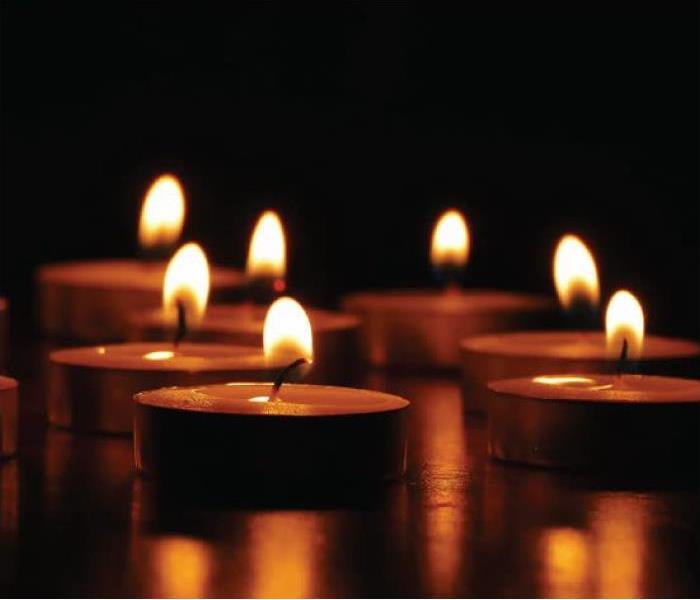 Candle Fire Safety
Candle Fire Safety
Candle Fires by the Numbers
- Candles caused 3% of reported home fires, 3% of home fire deaths, 6% of home fire injuries, and 5% of the direct property damage in home fires.
- Roughly one-third (36%) of home candle fires started in bedrooms. These fires caused 32% of the associated deaths and 47% of the associated injuries.
- Falling asleep was a factor in 11% percent of the home candle fires and 30% of the associated deaths.
- On average, 25 home candle fires were reported per day.
- More than half (58%) of home candle fires occurred when some form of combustible material was left or came too close to the candle.
- December is the peak time of year for home candle fires. In December, 11% of home candle fires began with decorations compared to 4% the rest of the year.
Candle Safety Tips
- Blow out all candles when you leave the room or go to bed. Avoid the use of candles in the bedroom and other areas where people may fall asleep.
- Keep candles at least 12 inches away from anything that can burn.
- Use candle holders that are sturdy, and won’t tip over easily.
- Put candle holders on a sturdy, uncluttered surface.
- Light candles carefully. Keep your hair and any loose clothing away from the flame.
- Don’t burn a candle all the way down — put it out before it gets too close to the holder or container.
- Never use a candle if oxygen is used in the home.
- Have flashlights and battery-powered lighting ready to use during a power outage. Never use candles.
The Dangers of Cracked Electrical Outlets
4/15/2019 (Permalink)
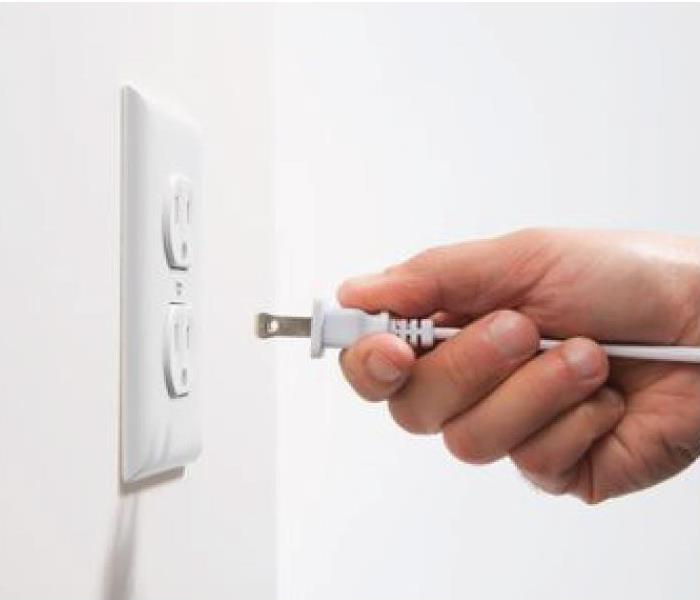 The Dangers of Cracked Electrical Outlets
The Dangers of Cracked Electrical Outlets
Electrical outlets provide such constant, convenient use that it can be easy to forget that they carry an electrical current that is protected only by a thin layer of rigid plastic that covers the inner metal parts of the outlet receptacle. Over time, the plastic faces of an outlet can dry out and crack, and it's likely that you've continued to use an outlet even when the plastic has a crack or two, never really considering the possible danger. Cracking is particularly likely on old outlets, which were manufactured from hard bakelite, an early form of plastic that is very brittle.
Here's a look at the hazards you can be exposed to if some of those plastic parts are cracked or missing.
Cracked Outlet FacesQuite commonly, the plastic right around the outlet slots can crack, and pieces can even chip away. Eventually, this piece of plastic can fall out completely and expose the metal contact points inside the outlet. Cracked faces also can expose the user to loose terminals and loose connection points for the cords that plug into them. All of these hazards present a shock risk and a potential fire hazard. If you see an outlet in this condition, don't use it until you replace the receptacle.
Cracked Cover PlatesThe outlet cover plate is an important safety device because it covers everything in the electrical box, including the electrical terminals (screws) on the sides of the outlet and the bare ends of the circuit wires. Touching these can give you a powerful shock. Cover plates also help to stabilize the outlets. When a cover is cracked the outlet can shift around within the electrical box, leading to loose wires and premature wear on the outlet.
Outlet BodyAlthough you can't see it from the front, if the solid plastic body or backplate of the outlet is cracked, the wiring and inner contacts can be exposed within the electrical box and cause a short circuit. If the box is metal, the exposed hot wire can short out on the box and trip the circuit breaker, shutting the circuit off—but usually not until sparks have flown and there is a loud "pop." If you happen to be touching the box at the time, you'll get a shock, too. Loose wires in any type of box or anywhere in an electrical circuit presents a serious fire risk.
Loose OutletsWhether due to cracks in the outlet face or simply wear and tear, outlets that don't securely hold the prongs on electrical cord plugs are another common problem. What this means is that the electrical contacts within the outlet have lost their tension and are failing to grip the plug prongs as they are supposed to. If the plug slips out partway, it can be quite dangerous, since the energized metal prongs are exposed.
Replace Damaged OutletsIf you have a bad outlet, don't hesitate to replace it with a new one. Wiring an outlet isn't hard to do yourself, but make sure you understand the process before attempting it. You may also have a GFCI (ground-fault circuit interrupter) outlet that needs replacing. GFCIs are an important part of your home's safety, and replacing one is also an easy project.
Cleaning Up After a Fire
4/8/2019 (Permalink)
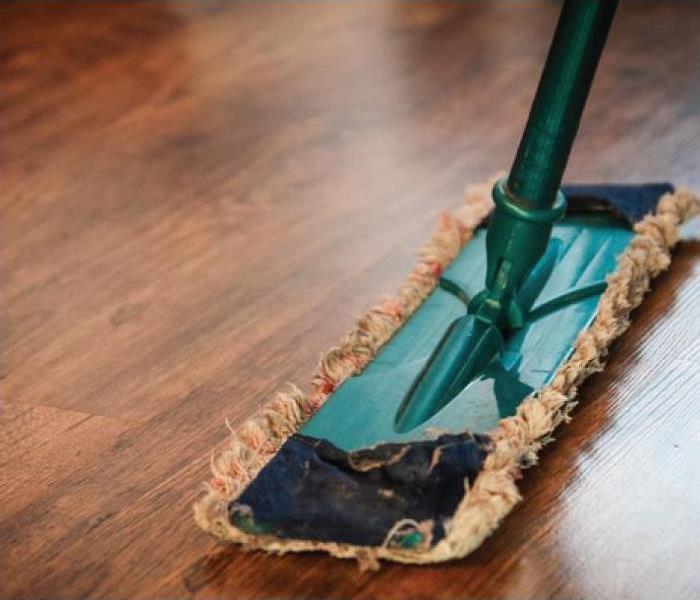 Cleaning Up After a Fire
Cleaning Up After a Fire
Cleaning Up and Removing Smoke Odor
- Products containing tri-sodium phosphate (TSP) can reduce odors in fabrics. TSP is caustic so be careful! Read the label for directions and safety instructions.
- Test garments before using any treatment, and follow the manufacturer's instructions. Smoke odor and soot can sometimes be washed from clothing that can be bleached. Measure 4 to 6 tbsp. Tri-Sodium Phosphate and 1 cup household cleaner or chlorine bleach for every gallon of warm water you will use. Alternatively, consider washing clothes in cold water with your usual household laundry detergent, and adding one tablespoon of pure vanilla extract.
- To remove soot and smoke from walls, furniture and floors, use a mild soap or detergent or mix together 4 to 6 tbsp. tri-sodium phosphate and 1 cup household cleaner or chlorine bleach to every gallon of warm water. Wear rubber gloves. Be sure to rinse surfaces with clear warm water and dry thoroughly.
- Wash walls one small area at a time, working from the floor up to prevent streaking. Rinse with clear water immediately. Ceilings should be washed last. Do not repaint until walls and ceilings are completely dry. Reduce the chances of growth of mold and mildew by wiping down all surfaces that had gotten wet with a solution of one cup of liquid household bleach to a gallon of water. (Test surfaces to ensure that the bleach solution will not discolor these surfaces. To conduct this test, wipe a small area of the surface with the bleach solution, and allow it to dry at least 24 hours.)
- Washable wallpaper can be cleansed like painted walls, but do not wet through the paper. Use a commercial paste to repaste any loose edges or sections.
Other Cleaning Tips
- Consult a professional about replacing drywall and insulation that has been soaked by water from fire hoses. It can not be dried out and maintain structural integrity or resistance to mold and mildew.
- Pots, pans, flatware, etc., should be washed with soapy water, rinsed and then polished.
- Wipe leather goods with a damp cloth, then a dry cloth. Stuff purses and shoes with newspaper to retain shape. Leave suitcases open. Leather goods should be dried away from heat and sun. When leather goods are dry, clean with saddle soap. Rinse leather and suede jackets in cold water and dry away from heat and sun.
- Wear protective clothing, including leather gloves and heavy soled shoes.
- Learn more about how to clean up after a home fire, including the supplies you’ll need, how to deal with contaminated food and water, and how to repair smoke and water damage.
- Follow public health guidance on safe cleanup of fire ash and safe use of masks.
- Wet debris down to minimize breathing dust particles.
Fire Safety and Your Pets
3/13/2019 (Permalink)
 Keep Me Safe!
Keep Me Safe!
Emergencies can happen at any moment and can come in a myriad of ways. While we may never be able to fully prevent such events from happening, we can prepare ourselves and our pets for when they do. Use this list to ensure that you and your furry friends are prepared should a fire break out.
- Consider installing monitored smoke detectors. If you live in a fire-prone area or are concerned about a fire potentially starting, monitored smoke detectors are always a smart choice. Should a fire start, firefighters will be notified and can respond, even if you’re not home.
- Note where your pets like to nap or hide. This is important in the event that you must evacuate your home quickly. Remember that pets can be exponentially more difficult to round up if they sense stress—especially cats! Practice crating your pets in advance to make it a positive experience so they don’t go running when you pull out their crate during any type of emergency.
- Have an emergency plan, and practice escape routes with your pet. Include all members of the family in this plan, and make sure they know what to do and where to go.
- Keep the phone number and address of a local animal hospital handy. If your pet is injured, you’ll need to know where to take them for treatment quickly.
- Pet-proof your home. Ensure there are no areas where pets can start fires accidentally (including stove knobs, loose wires, candles, fireplaces and other potential hazards). Never leave a pet unattended with a lit candle or fireplace.
- Get a rescue alert sticker. This easy-to-use sticker will let people know that pets are inside your home. Make sure it is visible to rescue workers (we recommend placing it on or near your front door), and that it includes the types and number of pets in your home, as well as the name and number of your veterinarian. If you must evacuate with your pets, and if time allows, write “EVACUATED” across the stickers.
- If you evacuate, take your pets with you whenever possible. If you leave them behind, they may become trapped or escape and be exposed to numerous life-threatening hazards. Note that not all shelters accept pets, so it is imperative that you have determined where you will bring your pets ahead of time:
- Contact your veterinarian for a list of preferred boarding kennels and facilities.
- Ask your local animal shelter if they provide emergency shelter or foster care for pets.
- Identify hotels or motels that accept pets.
- Ask friends and relatives in your area if they would be willing to take in your pet.
- Prepare emergency supplies and traveling kits. If you must evacuate your home in a crisis, plan for the worst-case scenario. Even if you think you may be gone for only a day, assume that you may not be allowed to return for several weeks. To minimize evacuation time, take these simple steps:
- Make sure all pets wear collars and tags with up-to-date identification information at all times. Your pet’s ID tag should contain their name, your telephone number and any urgent medical needs. Be sure to also write your pet’s name, your name and contact information on your pet’s carrier.
- The ASPCA recommends microchipping your pet as a more permanent form of identification. A microchip is implanted under the skin in the animal’s shoulder area, and can be read by a scanner at most animal shelters.
- Store an emergency kit and leashes as close to an exit as possible. Make sure that everyone in the family knows where the kit is, and that it is clearly labeled and easy to carry.
The 5 Benefits Of A Home Fire Alarm System
3/11/2019 (Permalink)
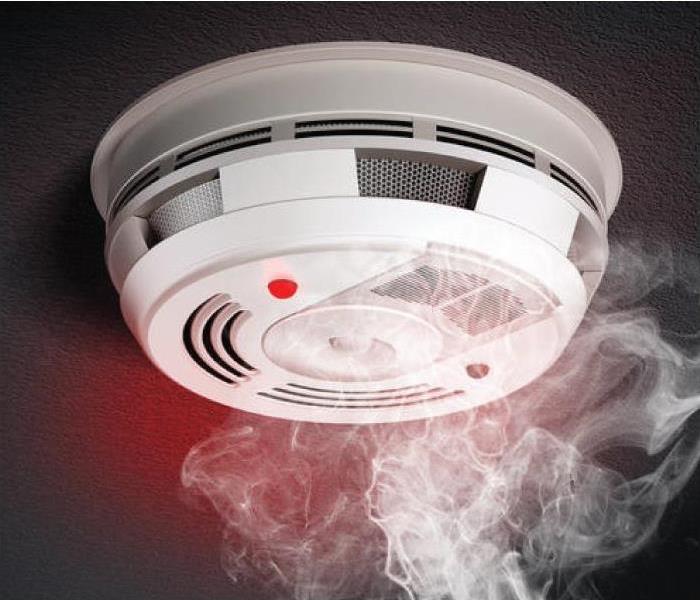 Fire Alarms Save Lives
Fire Alarms Save Lives
The earlier a fire is detected, the faster it will be that firefighters will respond. This can mean you may avoid major damage or even worse, the complete destruction of the home.AVOID SMOKE INHALATION
The most important reason is perhaps the only one you really need. This can save the life of anyone in the house at the time. This is particularly crucial at night time. Anyone who is sleeping may not be awakened in time if a fire starts. Many times people die of smoke inhalation while trying to escape. Having a system in place can give you peace of mind and security.
EARLY DETECTION
The earlier a fire is detected, the faster it will be that firefighters will respond. This can mean you may avoid major damage or even worse, the complete destruction of the home.
INSURANCE DISCOUNTS
This can save you money on your house insurance. Homeowner policies often give discounts to customers who have these systems. That is because it can be possible to save a home rather than lose it entirely. In addition, it demonstrates to the insurer that the homeowner is taking responsibility and is prepared in case an unfortunate incident should occur.
24/7 MONITORING
A home fire alarm system gives the homeowner protection 24 hours a day, every day of the week. You home will be monitored when you are away, and at night when you are sleeping. You and your family can feel secure knowing this monitoring never stops.
EASY & AFFORDABLE
Having a system is very reasonably priced. Even if you have insurance that can replace any lost items, many of them are irreplaceable. This would include photo albums, gifts from family members or items passed down from one generation to the next. You also would be severely inconvenienced by having to live elsewhere for at least some time. Finally, there is the emotional trauma of losing your home and possessions.
Facing Fire or Smoke Damage?
2/27/2019 (Permalink)
When disaster strikes, severe fire damage can be the most devastating thing to happen to any property. As fire becomes an increasingly prevalent threat, insurance companies are constantly trying to cut corners on fire insurance claims in an attempt to save money. After a fire, you've most likely lost some personal belongings and areas of your home are completely destroyed. The last thing you need is a homeowners' insurance company giving you a hard time regarding your claim.
First Things First, Check Your Policy
Even if you have replacement coverage for your home you actually may only have "actual cash value" for the personal items that were lost. When you call your insurance company, your agent should notify you about this and suggest buying an endorsement so that your belongings will be covered under a replacement policy.
Secure Your Property
The majority of homeowners coverage policy requires you to take reasonable steps to minimize more harm on your property. In short terms, this is known as your duty to mitigate damages. These steps are fairly small and easy to do, such as covering leaking areas with plastic wrap or turning off the water if you discover a huge pipe burst. Your insurance company will most likely pay these costs when you make your claim.
File Your Claim Immediately
Every homeowner policy will require you to report your loss as soon as possible. You will need to make a call to your agent and submit a "proof of loss claim" in which you will itemize your losses in detail and list the value of each. The longer you wait, the faller you fall down the list when it comes time for the company to send an adjuster to deal with your claim.
Always Keep Track Of Your Living Expenses
Every homeowners policy will include a loss of use clause, which entitles you to adequate reimbursement for living expenses while you're out of your home. Keep in mind, these expenses only include additional living expenses, meaning the difference between what it costs you to live on a daily basis and what it is costing you now. For example, if you ate the majority of your meals at home and your groceries cost you $400 a week and now, after a fire, you're eating out and spending $500 a week, you can claim only that additional $100.
Fire Season
5/15/2014 (Permalink)
 Wild fire threatens home
Wild fire threatens home
As summer approaches we find ourselves facing "Fire Season". Dry weather combined with record-breaking heat has made CA prime territory for wildfire. Dead and dry vegetation combined with high winds creates a hazardous environment where fires are common. If you have any fire damage to your home, call SERVPRO to come and restore your property. Our technicians are equipped with specially designed tools and chemicals to remove soot particles from any materials in your home or business. Remember, the fire doesn't have to happen inside your building in order for you to be effected by smoke damage. Outside fires can cause smoke to enter and damage your walls, furniture, air ducts, etc.
Things a home fire inspector may review
9/11/2013 (Permalink)
SERVPRO Fullerton Placentia is concerned with the safety of our customers. Here are some things a home fire inspector may review.
- A proper ground. “One thing a home fire inspector should check is to make sure your home is grounded,” says Bill Burke, division manager of electrical engineering for the National Fire Protection Association. Grounding diverts excess current that may result from an electrical surge and helps to keep electrical systems, devices and humans safer.
- Electrical panel. “There should be air space around the main panel,” Burke says. Inside, there shouldn’t be evidence of overheating or corrosion, and the fuses and breakers should be the correct size.
- Appliances. “If you have a device that’s going to cause a home fire, it’s most likely going to be one that draws a lot of current,” Burke says. Inspectors might check the integrity of cords and plug-ins on fridges, stoves and other large appliances.
- Out-of-date equipment. A home fire inspector can suggest improvements to reduce the risk of an electrical fire. One important update would be to install arc-fault circuit interrupters, which are designed to detect fire-starting arcs and shut down power.
- General safety concerns. The inspector also should look for electrical hazards such as receptacles and switches that aren’t functioning properly, lightbulbs exceeding the maximum wattage, damaged cords and overloaded power strips.
 Unexpected fires can be devastating to your home. That's why SERVPRO of East Fullerton/Placentia can restore your home with a quick response. Call us!
Unexpected fires can be devastating to your home. That's why SERVPRO of East Fullerton/Placentia can restore your home with a quick response. Call us!






 24/7 Emergency Service
24/7 Emergency Service
